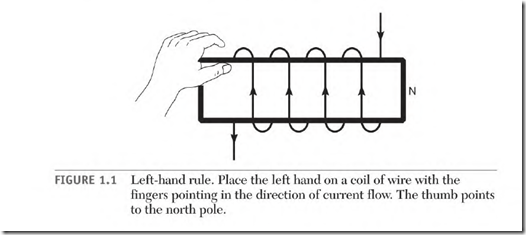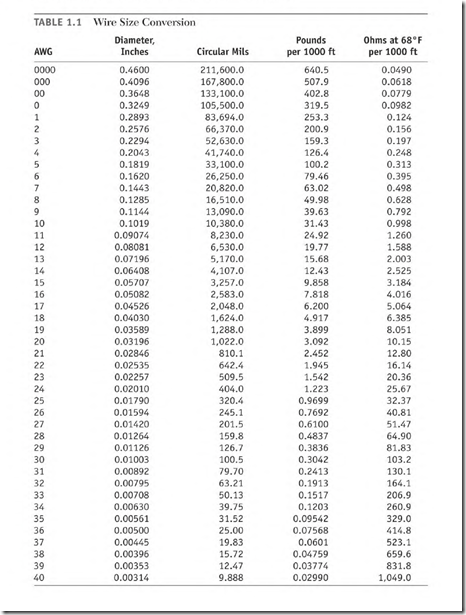This wire table can be remembered very easily if a few simple points are kept in mind:
![]() A wire three sizes smaller than another wire has half the area of the larger wire. For instance, No. 20 AWG copper wire has half the area of
A wire three sizes smaller than another wire has half the area of the larger wire. For instance, No. 20 AWG copper wire has half the area of
No. 17 AWG copper wire. Therefore, two No. 20 wires in parallel have the equivalent area of one No. 17 wire.
![]() A wire three sizes smaller than another wire has twice the resistance of the larger wire.
A wire three sizes smaller than another wire has twice the resistance of the larger wire.
![]() A wire three sizes smaller than another wire has half the weight of the larger wire.
A wire three sizes smaller than another wire has half the weight of the larger wire.
![]() A No. 10 AWG copper wire is approximately 0.10 inch in diameter, has an area of approximately 10,000 circular mils, and has a resistance of I ohm per 1000 feet.
A No. 10 AWG copper wire is approximately 0.10 inch in diameter, has an area of approximately 10,000 circular mils, and has a resistance of I ohm per 1000 feet.
If there are too few circular mils per amp, the coils will overheat and the motor’s insulation will deteriorate prematurely. Excessive heat increases copper loss and lowers the motor’s efficiency. Copper gains resistance as its temperature rises. As copper resistance goes up, the amperes go down, lowering the motor’s horsepower output.
Ohm’s Law
The relationship of voltage, amperes, and resistance is explained with a formula called Ohm’s Law. The following formulas, in which E (electromotive force) volts, I (intensity of current) = amperes, and R resistance, predict the results when designing electrical devices:
Volts divided by resistance equals amperes (E + R = I)
Volts divided by amperes equals resistance (E + I = R)
Amperes multiplied by resistance equals volts (I X R E)
Varying the voltage or the resistance controls amperes.
Watt
The word watt is short for joules per second. A watt is the measurement of power being used to do work. The number of watts is found by using the formula volts X amperes = watts. A power meter (which determines power cost) multiplies volts x amps and measures the time involved. The cost is determined by the kilowatt hour (1000 watts for 1 hour).
A motor converts electrical energy directly into mechanical energy. One horsepower (hp) equals 746 watts. One horsepower has the ability to lift 550 pounds 1 foot in 1 second.
Watts and horsepower are directly related to the physical size of motors. Some motors are rated in kilovolt amperes (kVA) instead of horsepower. All transformers are rated in kVA.
The formula (volts X amperes watts) shows that when the number of watts is constant, as the number of volts goes up, the number of amps goes down. For example, assume 1000 watts are required for a given load. If the power supply were 10 volts, it would take 100 amperes to produce 1000 watts of power. The wire size would have to be large to carry 100 amperes. With a 100-volt power supply, only 10 amperes are needed to produce 1000 watts. The wire size required would be much smaller. This is the reason large electric motors are designed to operate on high voltage.
Low amperes allow smaller wire to be used. Power lines are a good example of this. On the high-voltage (power line) side of a transformer, the wires are very small compared to those on the low-voltage side (load side).

